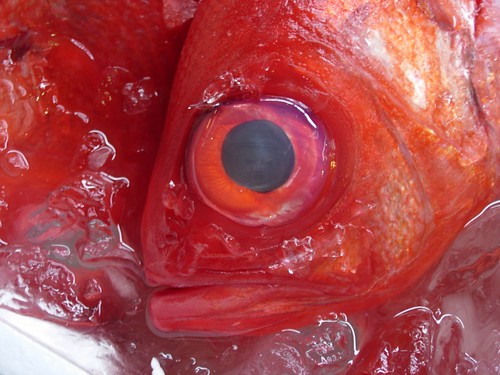Jennifer Mayo-Smith Talks to Wild About Health about Wild Blueberries, Sea Salt, and Maine’s Influential Role in Connecting Us with Our Food
When Jennifer Smith-Mayo started paying attention to how much food is produced in Maine, she said she was astonished. “You can find most anything that you need, from fresh greens to artichokes to berries and fruit to wheat and oats to free-range meat and bounty from the sea,” she said. Her close attention to local food led to discoveries about techniques used by local food producers, challenged her to eat food in season, and even influenced her own home farming techniques.
 |
| Wild blueberries were the inspiration for a project and a personal journey. Photo by Jennifer Smith-Mayo. |
For example, by learning from Eliot Coleman and Barbara Damrosch from Four Season Farm in Harborside about extending the harvest season, she extended her own harvest well into December. “Their farm is a testament to how it is done,” she said. “Last year I had spinach ready for harvesting in April.” It was good, practical work that was ultimately in service to art. It became “Growing Local”, a two-part documentary series about local food in Maine.
The project uses still photography and audio interviews along with ambient sound to document traditional recipes and trace the origin of the ingredients through their sellers and producers. A selection of photography from the project will be shown during the month of March at the Barbara Kramer Gallery of Belfast Free Library.
A Tin of Wild Blueberry Muffins
The first part of the documentary series, “Growing Local: Wild Maine Blueberry Muffins,” was sparked by one of Maine’s beloved foods: wild blueberries. It was something as simple as making a tin of blueberry muffins that became the inspiration. They weren’t just any muffins – they were muffins made completely with Maine ingredients that were locally sourced. Northport resident Smith-Mayo had picked the blueberries from her own blueberry barren and acquired the other ingredients from her neighbors, or at the Blue Hill Co-op. The idea that she could have such a unique relationship with what created the muffins had an impact. She already had a passion for cooking and for local food, and she was intrigued with the idea of exploring the connection between us and the food we eat. It became both a project and a personal journey.
A professional photographer whose work has documented rural living, farming, and fine dining, Smith-Mayo’s images of small town life in Maine have been featured often in Down East Magazine, among many other publications, and she recently co-authored Maine Icons: 50 Classic Symbols of the Pine Tree State with her husband, writer Matthew P. Mayo. Part of the goal of investigating food and its producers and sellers for “Growing Local” was to generate awareness of the importance of using local foods by taking traditional regional recipes and adapting them for use with only local ingredients. With wild blueberry muffins as the catalyst for this multi-faceted exploration, she turned muffin-making into a deeply engaged cultural act: for “Growing Local: Wild Maine Blueberry Muffins,” she met the ingredients’ producers, learned about the recipe’s history and explored the effect that supporting producers has on the economy.
Maine’s Food & Farming Renaissance
While iconic foods like lobsters, wild blueberries and potatoes are commonly embraced, that’s just the beginning of Maine’s role as a leader in the local food initiative, said the author and photographer. “It starts with something that most practical Mainers have done for centuries: raising veggies in their vegetable gardens,” she said. “You know spring has arrived when talk at the general store borders on frenzy about wet weather and trying to get the peas in.”
Smith-Mayo cites the increase in farms in Maine, the overwhelming amount of which are small farms, and the burgeoning number of winter and summer farmer’s markets as indications of the state’s renaissance in farming. She also gives a credit to Maine chefs and their notable restaurants, using Primo in Rockland and Chase’s Daily in Belfast as two fine examples of restaurants that grow some of the food that appears on their menus.
Our connection to food is particularly strong in Maine, Smith-Mayo said, and is strengthened by the improved transparency in our local grocery stores and markets like the Belfast Co-op. “Signs and labels that declare where the food was grown, where it was processed, are critical in making food-buying choices,” she said. “I look for those signs – if one bag of apples is from Argentina and the one next to it is from Maine, I buy the Maine apples. Nothing against the growers from Argentina, I just prefer to support our local community whenever I can.” She also references The Maine Department of Agriculture’s “Get Real, Get Maine” program, a successful Farm to School program, and the Seniors’ Farmer’s Market Nutrition Program, which provides Maine senior citizens with locally produced food, as initiatives that have put Maine ahead of the pack when it comes to local, healthy, real food initiatives.
That natural connection to food was all part of what prompted her to dig deeper for the project. She wanted to learn the back-story of local food – to understand the process of producing maple syrup, to learn about who grew and milled the wheat into flour in Aroostook, and to see what was involved in creating Maine Sea Salt (hint: add a little sun). We can benefit from her journey through Maine and its food by viewing a selection of photographs from “Growing Local: Wild Maine Blueberry Muffins” this month. The full Growing Local project will include an enhanced e-book and DVD and it will be avail able in the fall.
Find our more about Jennifer Smith-Mayo and Growing Local Exhibit at www.jennifersmithmayo.com.




